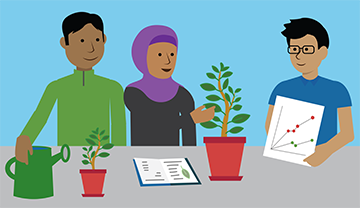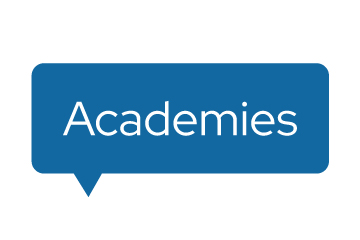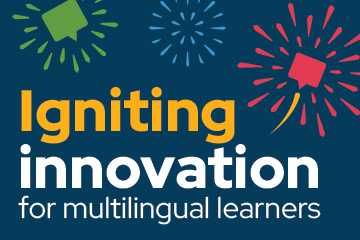Many literacy programs were not designed to effectively use multilingual students’ knowledge, skills, and strengths. This Snapshot is the fourth in a five-part series that provides insights from relevant research and suggests ways to engage the significant strengths that multilingual learners bring to their literacy development.
How can we support students’ reading comprehension in a content class?

Across subject areas, there are different types of texts that multilingual learners will read and use to make meaning of the content they are learning. Students may start their day reading like a historian, focusing on reading various texts to understand multiple perspectives of a historical event. Later, they may read like a scientist to understand how a natural phenomenon works. Research suggests that when students are taught to read with purpose, like a historian or scientist, that they are better able to comprehend and think critically about the text (Grabe & Yamashita, 2022; Shanahan & Shanahan, 2008).
Connect home literacy practices to the classroom.
Multilingual learners come to classrooms with diverse experiences, skills, and knowledge that connect to reading comprehension. According to research, everyday practices such as critiquing a music video, interpreting religious texts, or translating a message for a family member are valuable literacy experiences that support the development of academic literacy (Lee, 2014; Martinez et al., 2008; Pacheco, 2015). Additionally, students benefit when these home and community literacy practices are valued and brought into the classroom as academic resources for learning (Souto-Manning, 2016).
“First, acknowledging that every child comes with knowledge and building from such knowledges as resources and not deficits; second, not merely "using" existing knowledge as a transitory stepping stone to further knowledge, but also embracing ways that broaden current definitions of the norm so teachers and children from dominant cultural groups broaden their views of what counts as language and literacy (no longer perceiving their own ways as single truths).” Souto-Manning, 2010
Watch elementary educator Carmen Sieleni connect students’ home literacy practices to a text about a lunar landing.
To incorporate students home literacy experiences
- Build on and connect students’ existing knowledge to classroom content.
- Learn about students’ home literacy practices through activities like a community literacy map or empathy interview (see page 13 of this WIDA Focus Bulletin on reading)
Engage readers in strategy practice
Another factor in successful reading comprehension is a reader’s ability to engage strategically with a text (Duke & Carwright, 2011). For example, a strong reader can recognize when their comprehension has broken down and is able to use strategies to repair their comprehension such as re-reading a portion of text or looking up a translation of a word. Therefore, it is important that multilingual learners are taught reading comprehension strategies and engage in frequent discussions about their comprehension of text (Duke & Cartwright, 2011; Grabe & Yamashita, 2022). During reading strategy instruction, students are intentional and conscious in the way they are using a reading strategy; however, the aim is that over time, the use of the strategy becomes increasingly automatic and subconscious, just like learning to type on a keyboard or ride a bike (Grabe & Yamashita, 2022).
“But the real goal for comprehension strategies is the use of effective strategies without continuously needing to move to a level of conscious problem solving.” Grabe & Yamashita, 2022
To work on building control of reading strategies
- Provide opportunities for students to use all of their language skills and knowledge to make sense of text, and to build on prior literacy experiences in English and other languages.
- Utilize classroom routines that promote discussion of text, and the way students understood the text, i.e. ‘How did you know that is what the author meant?’
Explicitly teach language patterns in text.
For a reader to comprehend a text, they must be able to understand how the ideas within the text are organized (Grabe & Yamashita, 2022; Shanahan & Shanahan, 2008). Additionally, effective readers understand how authors signal the way various ideas within a text are connected (Grabe & Yamashita, 2022). Furthermore, the norms and practices of a subject area shape the language patterns within a text. For example, a scientific report is likely to have sections such as hypothesis, methods, results, etc., whereas a biography is likely to be organized in a sequence of events. These patterns signal to a reader how the ideas, events and reasons are linked across the text.
Just as students need to be aware of how a text is organized, students also need to understand the ways sentences and words are used to connect ideas and convey meaning for that type of text (Grabe & Yamashita, 2022). Exploring and explicitly teaching the language features (e.g., types of sentences, phrases and words) that are characteristic of a text type, highlights for multilingual learners what is not picked up by chance and allows them to build independence in their reading comprehension skills.
To explicitly teach text structure
- Preview organization and discuss why authors organize a text the way they do.
- Prioritize a few key language features for students to explore (see pages 29-30 of the WIDA ELD Standards Framework, 2020 Edition).
More Learning
Take the WIDA self-paced workshop “Reading Comprehension Across Content Areas with Multilingual Learners.” (WIDA Secure Portal account required)
References
Duke, N. K., & Cartwright, K. B. (2021). The science of reading progresses: Communicating advances beyond the simple view of reading. Reading Research Quarterly, 56, S25-S44.
Grabe, W. & Yamashita, J. (2022). Reading in a second language: Moving from theory to practice (2nd ed.). Cambridge University Press. https://doi.org/10.1017/9781108878944
Lee, C.D. (2014). The multi-dimensional demands of reading in the disciplines. Journal of Adolescent & Adult Literacy, 58(1), 9-15. https://doi.org/10.1002/jaal.316.
Martínez, R. A., Orellana, M. F., Pacheco, M., & Carbone, P. (2008). Found in translation: Connecting translating experiences to academic writing. Language Arts, 85, 421-431.
Moje, E. B. (2015). Doing and teaching disciplinary literacy with adolescent learners: A social and cultural enterprise. Harvard Educational Review, 85(2), 254-278.
Pacheco, M. (2015). Bilingualism-as-participation: Examining adolescents’ bi(multi)lingual literacies across out-of-school and online contexts. In D. Molle, E. Sato, T. Boals, and C. Hedgespeth (Eds.), Multilingual learners and academic literacies: Sociocultural contexts of literacy development in adolescents (pp.135-165). New York: Routledge.
Shanahan, T. and Shanahan, C. (2008). Teaching disciplinary literacy to adolescents: Rethinking content-area literacy. Harvard Educational Review, 78(1), 40-59.
Souto-Manning, M. (2016). Honoring and Building on the Rich Literacy Practices of Young Bilingual and Multilingual Learners. The Reading Teacher, 70(3), 263–271. doi: 10.1002/trtr.1518
Souto-Manning, M. (2010). Challenging Ethnocentric Literacy Practices: [Re]Positioning Home Literacies in a Head Start Classroom. Research in the Teaching of English, 45(2), 150–178. http://www.jstor.org/stable/40997088





